

Damion Smy
Suzuki Fronx recalled after seatbelt failure sparks ‘urgent investigation’
7 Hours Ago
Where expert car reviews meet expert car buying – CarExpert gives you trusted advice, personalised service and real savings on your next new car.
The BMW XM was, in some ways, a warning.
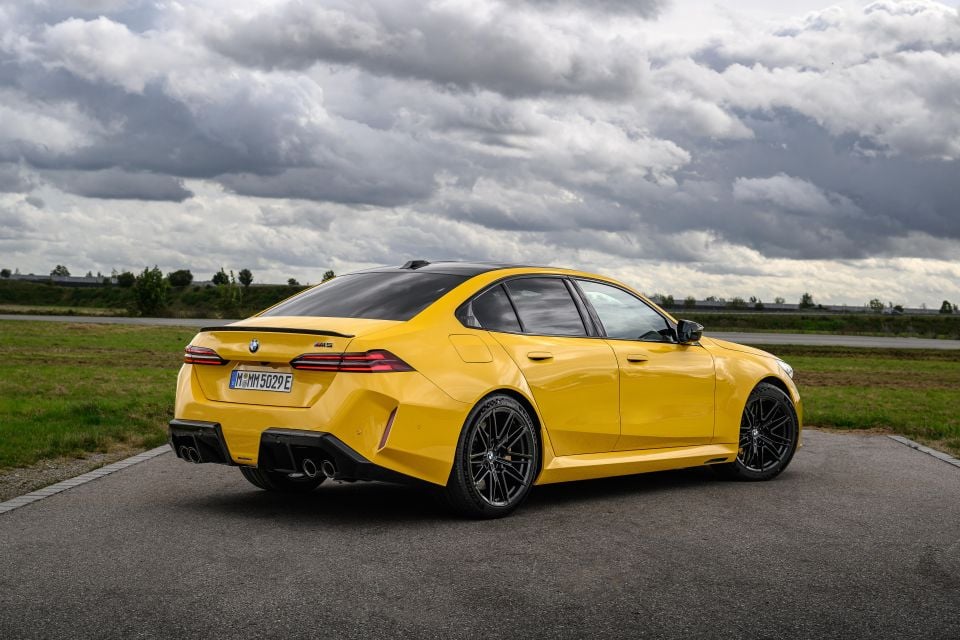
While we all focused on just what a colossally ugly thing it is, the XM was acting as something of a Trojan Horse, getting us all warmed up for the introduction of electric power to BMW’s venerated M cars.
In fairness, the M badge is already no stranger to battery power, and in fact the best-selling M-badged car in the world right now is the all-wheel drive, all-electric i5 M60 sedan.
So perhaps it should be no surprise that the new BMW M5 uses battery power too. And yet… it kind of does feel like a surprise.
At the M5’s launch event in Munich, BMW rolled out a lineup of historic M5s, and aside from the weird sideways step that was the 2003 V10-engined E60 version, you can see a slow and steady evolution in the M5 family tree, from the 3.5-litre straight-six E28 model of 1984, right the way through to the almost-unspeakably brilliant 4.4 twin-turbo V8 M5 CS of the F90 generation.
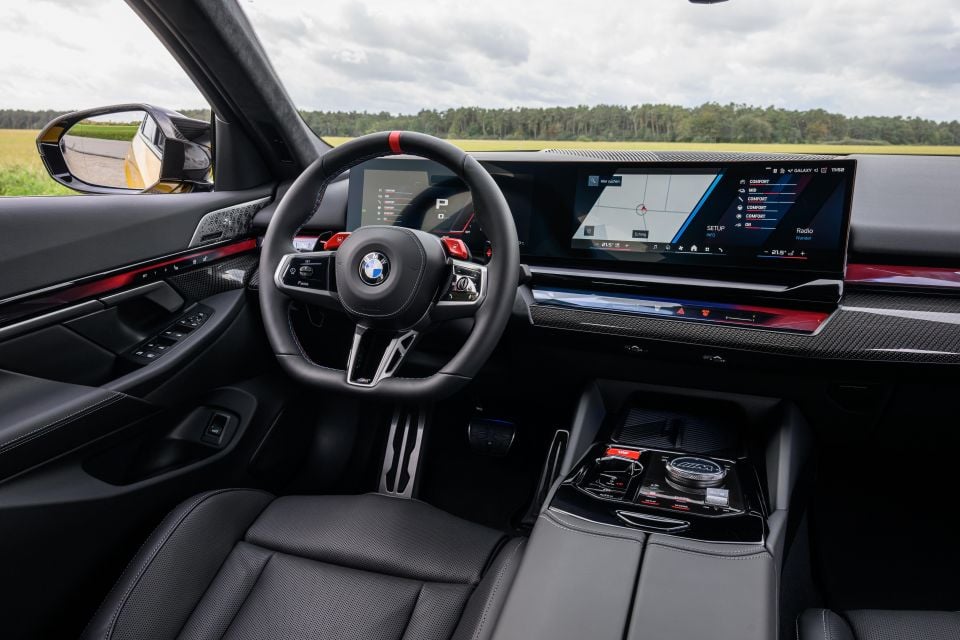
Now, suddenly, we arrive at G90 and the M5 has become a plug-in hybrid, and one with fearsomely complicated systems working away under its familiar 5 Series-shaped skin. And that’s before you get to the fact that the kerb weight has ballooned to 2510kg.
Given that the M5, historically, has always been about delivering maximum driving pleasure with practical everyday usability, how can something this heavy, complicated and potentially over-blown still be a proper M5?
The new M5 sedan is priced from $259,900, which certainly isn’t cheap, but is almost $14,000 less than the old M5 Competition and similar to what the previous Mercedes-AMG E 63 S 4Matic cost. We still don’t have a price for the new-shape E 63, so we’ll have to wait and see how the BMW compares on that score.
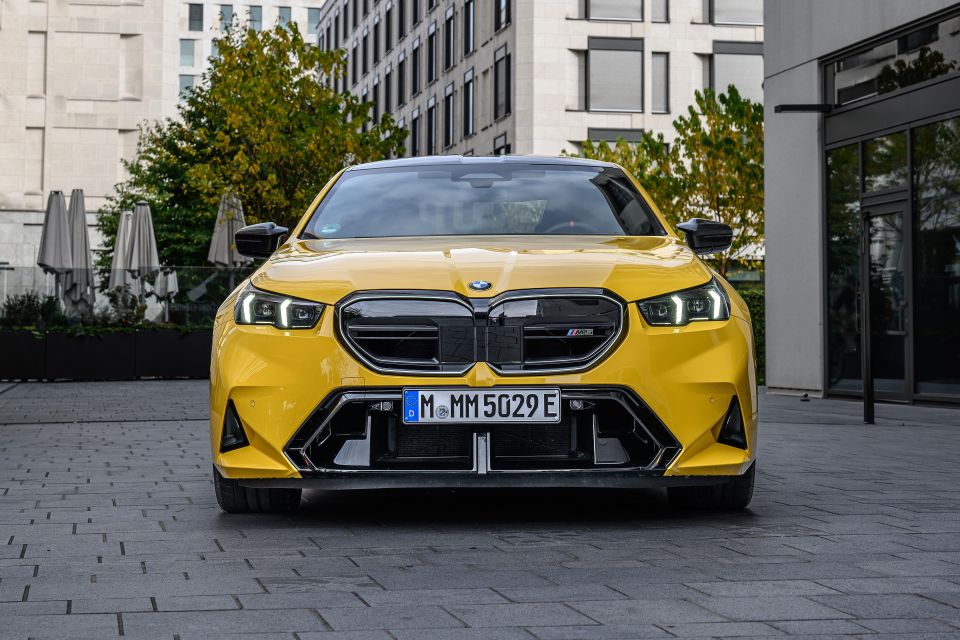
Given the new M5 is a plug-in hybrid with reasonable all-electric range, that makes the price potentially easier to swallow.
To see how the BMW M5 compares with its rivals, use our comparison tool.
Buy your new car without the stress. It's fast, simple and completely free.

Great service from Travis and team, second time I have used this business would not hesitate to recommend them to anyone
Craig C.
Purchased a Ford Ranger in Sunshine Coast, QLD
CarExpert helped Craig save thousands on his Ford Ranger, now let us save you on your next new car.
Find a dealIf you’ve seen or sat in any current 5 Series or i5, you know what to expect. The M5 might be the range-topper, and something of a totemic car for BMW as a whole, but the regular 5 Series cabin is essentially what you get here with plenty of M-flavoured upgrades.
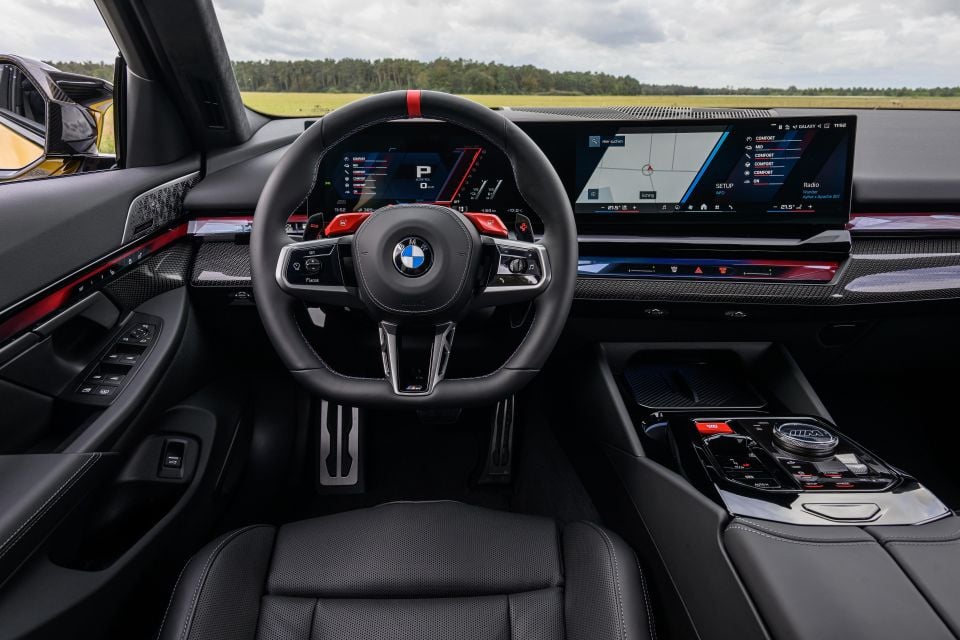
Space is very good front and rear, even though BMW has fitted the new M5 with a set of spectacularly comfortable front seats that tread a near-perfect line between support when cornering hard and comfort when cruising.
Four adults should fit in without any complaints, although the boot has shrunk by 100 litres compared to the standard 5 Series because of a need to package in so much extra hardware, and its 466-litre volume seems a bit stingy. More excuses to buy the new M5 Touring wagon, though…
Sitting up front, there’s the same big sweep of combined 12.3-inch driver’s digital instrument panel and 14.9-inch central infotainment screen that you’ll find in most current BMW products.
Digitally speaking, it’s a good setup, although we take issue with some of the menu structures as they’re too complex to easily find your way around when on the move, and the graphics are too video-game-like at times.
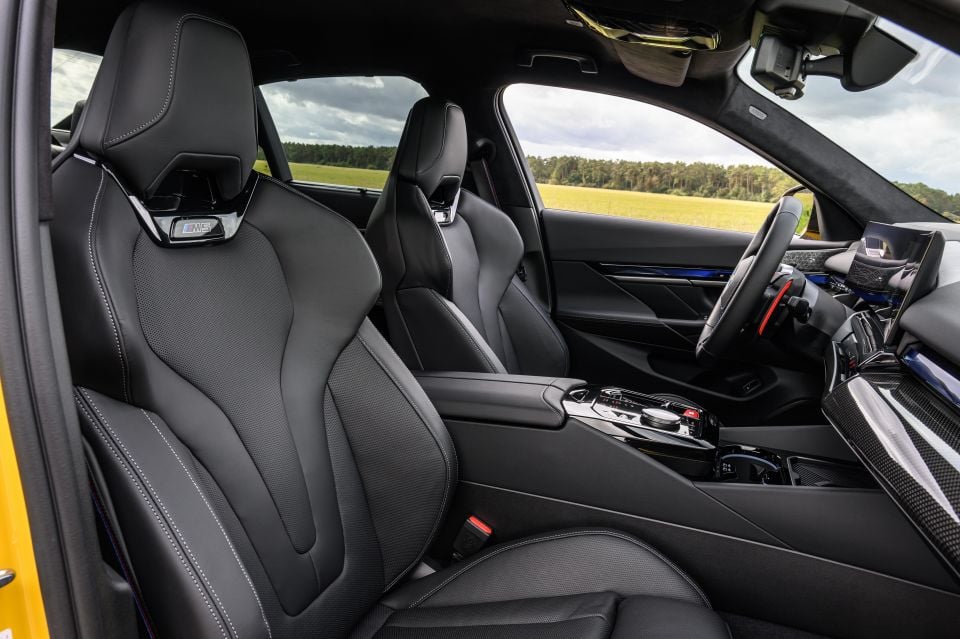
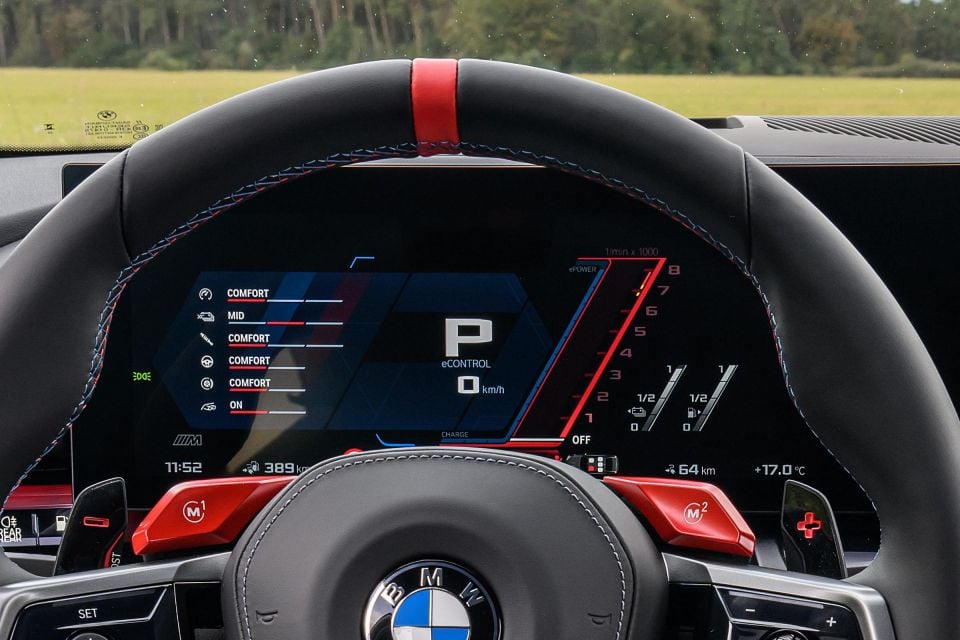
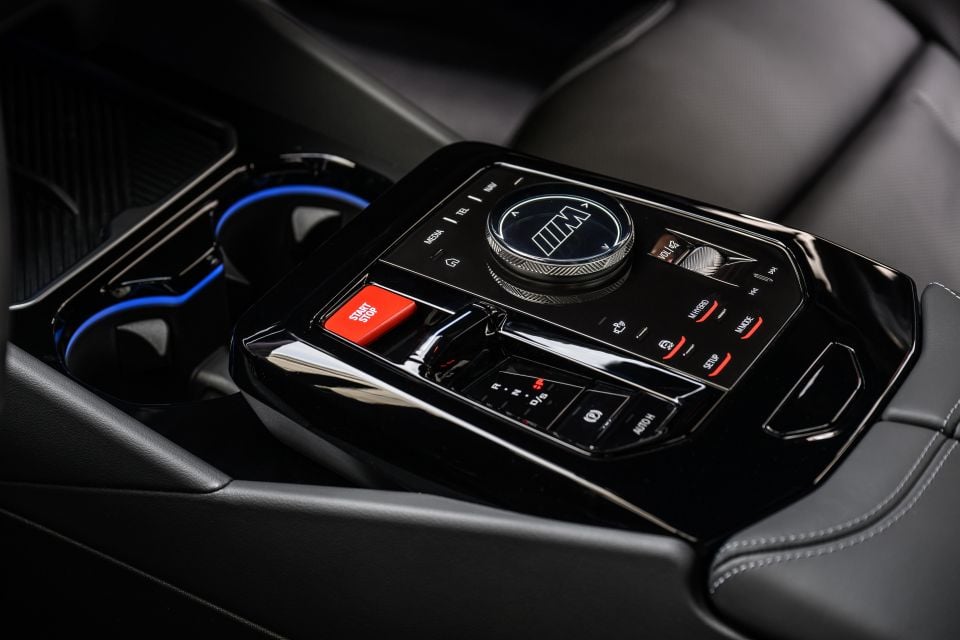

The M5 does retain the traditional iDrive click-wheel controller on the centre console, which allows you at least some tactility when fumbling your way around the on-screen menus, but please BMW – bring back physical air-conditioning controls.
Delve into the settings – doing so fully could well take a day out of your life – and you’ll find M-specific displays and colour schemes, including one for tyre pressures and temperatures that uses a graphic of an original BMW M1, a neat touch.
The driving position is pretty well perfect, and minor controls such as the column stalks and the few physical buttons all look and feel good to use. The only exception are the electric window switches, which have a nasty, cheap-feeling plastic surround.
The light bar that runs in sections across the dashboard has its uses – it can flash warnings at you when needed, for example, although mostly it’s there for ambient light – but the crystal-style surface looks a bit ‘Vegas.’ Thankfully, though, BMW has resisted the temptation to fit a needless passenger-side touchscreen.

There is a slight lack of practical space in the front of the M5, though. The door bins are a good size, and there are two wireless phone chargers beneath the main part of the dash, as well as two cupholders, but the storage area under the central armrest is a bit shallow.
The steering wheel is flat-bottomed, and slightly less over-stuffed in the rim than has previously been the case for M cars. It feels great to hold, while the bright red 12 o’clock indicator at the top is a nice touch, a colour echoed on the engine-start button.
Behind the wheel are fabulously tactile carbon-fibre shift paddles for the eight-speed automatic gearbox, and in front of those are the little M1 and M2 memory buttons, which allow you to pre-set two distinct groups of driving settings.
Most drivers will likely set one up to a softly-softly hybrid driving mode, and the other to an everything-at-maximum level, so that’s exactly what we did.
To see how the BMW M5 compares with its rivals, use our comparison tool.
As well as what’s under the bonnet, we need to pay close attention to what’s under the floor. Under the bonnet is a familiar friend, BMW’s 4.4-litre twin-turbocharged V8 petrol engine, here producing 430kW. That’s quite a bit less than produced by the previous M5’s V8 but hold on – let’s stick a pin in that for now.
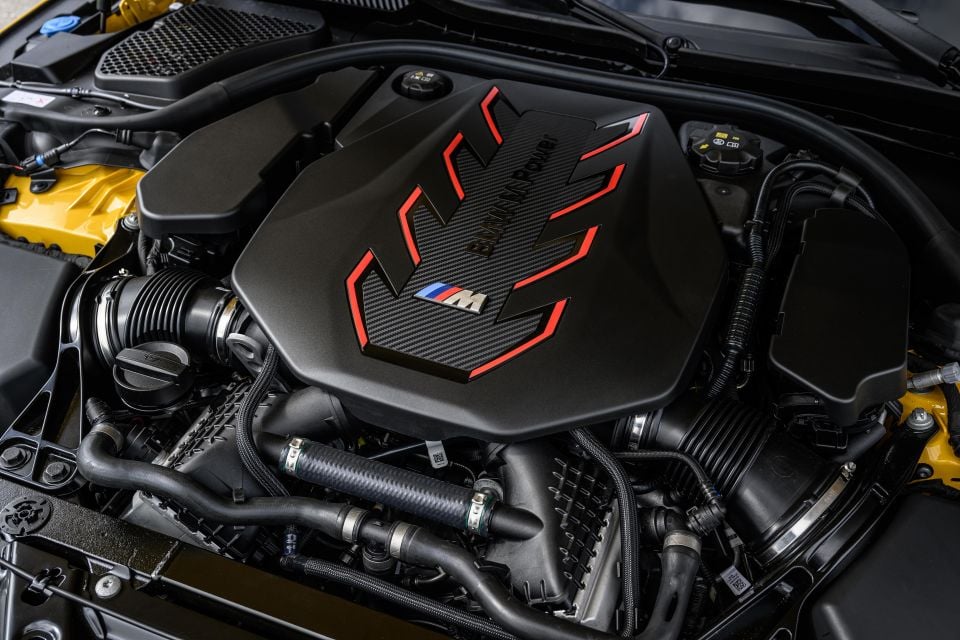
| Specifications | BMW M5 sedan |
|---|---|
| Engine | 4.4L V8 twin-turbo PHEV |
| Engine outputs | 430kW + 750Nm |
| Electric motor outputs | 145kW + 280Nm |
| System outputs | 535kW + 1000Nm |
| Battery | 18.6kWh lithium-ion |
| Transmission | 8-speed auto |
| Driven wheels | AWD |
| Weight | 2510kg |
| Fuel economy (claimed) | 1.7L/100km |
| Fuel economy (as tested) | N/A |
| Electric driving range (PHEV) | 69km |
| Fuel tank capacity | 60 litres |
| Fuel requirement | 95-98 RON |
| CO2 emissions | 39g/km |
| Emissions standard | Euro 6e |
Under the floor is an 18.6kWh battery pack, which charges up in a little over three hours from the AC socket in the front wheelarch (no high-speed charging for the M5, ironically). That feeds current to a 145kW electric motor, sandwiched in with the eight-speed automatic transmission.
Combined, the petrol and electric motors produce a colossal 535kW – the power of a frontline racing car not so long ago. There’s a ridiculous 1000Nm of combined torque to go with that too. These are epic outputs for a car that is also designed to transport four people in comfort.
To see how the BMW M5 compares with its rivals, use our comparison tool.
You assume, before setting off, that two things are going to dominate the M5’s driving experience – the weight, and the power, with one trading off against the other.
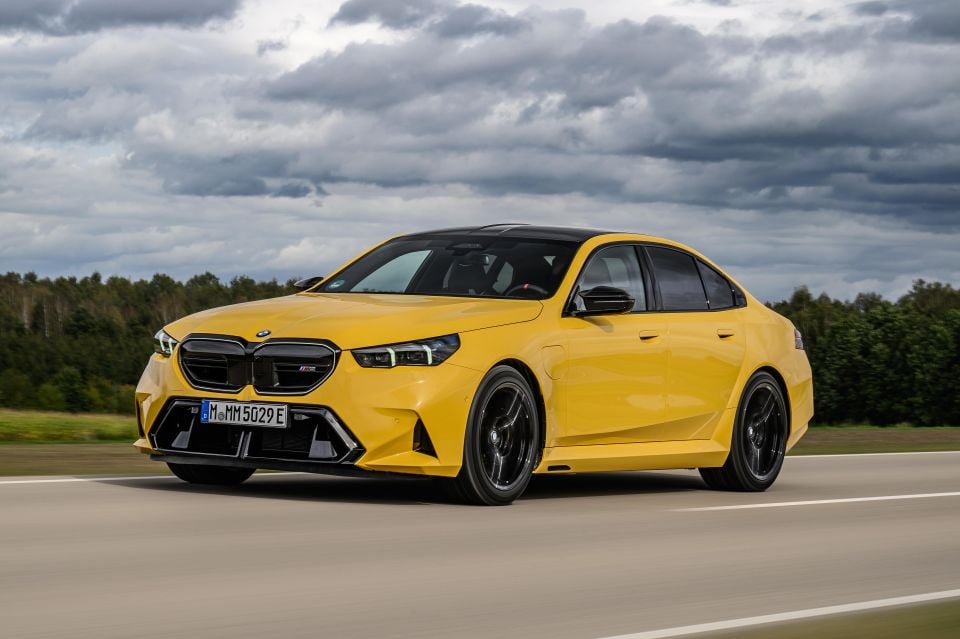
That turns out now to be the case. At low speeds, the M5 drives much like any other 5 Series, albeit a little bit firmer thanks to its more focused suspension.
BMW considered fitting an active-anti-roll system but decided against it, as it would have added too much weight and complexity. It’s a good thing too, as the lack of such a system allows the M5 to lean just a little in corners, which helps to keep the ride comfortable and also telegraphs important messages to the driver about what the car is up to.
You could easily commute every day in an M5, making the most of its official 69km electric range (50km seems like a more realistic figure) and never know anything about the beast chained up in its metaphorical cellar. However, find the right road and…
The right road in this case being the A9 Autobahn just outside Munich, and adjacent to BMW M’s headquarters in the town of Garching. The A9 is a busy route, shuttling drivers and freight from Munich to Stuttgart and beyond, but just occasionally it clears. Just occasionally the adaptive speed limit signs flash to the famous three black lines on a white background – the sign of a stretch on which there is no speed limit.
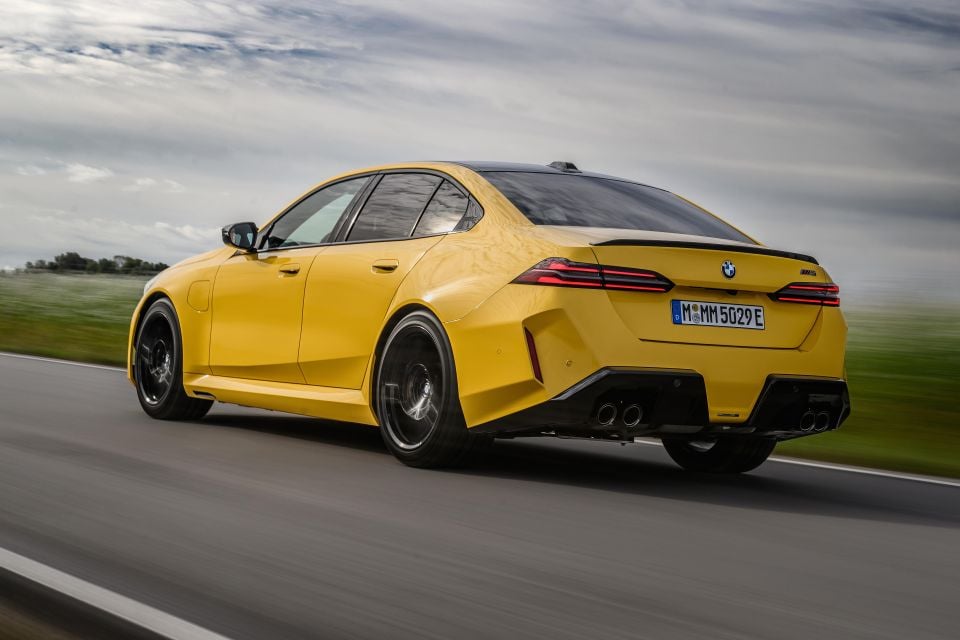
At which point, the M5 obliges. Clearly, 535kW is never going to feel slow, but in this case it doesn’t feel quite as insane as you might expect. Doubtless the smothering effect of the kerb weight plays a part there, but so too does the xDrive four-wheel-drive system (there is a brains-out rear-wheel drive mode for those brave enough) and the M5’s superb suspension. Find a gap in the traffic, press the go pedal and…
Wham! We arrived at an indicated 275km/h without any apparent effort, the M5 still pulling hard when slower traffic pulled into our lane up ahead, and discretion overtook valour. On paper, the M5 seems like a bit of a disappointment — its 0-100km/h time of 3.5 seconds is beaten by the old M5 CS by some margin.
However, once the big wheels are rolling, the new M5 comes into its own as an earth-shattering performer. It’ll clear 80-120km/h in just 2.2 seconds in fourth gear. Overtaking in the M5 bends the laws of physics enough to put Isaac Newton’s teeth on edge.

The M5 will run on to a top speed of 305km/h if you’ve picked the M Driver Package option, which removes the standard 250km/h limit.
Of course it was going to be fast in a straight line – 535KW will do that – but with that massive, SUV-like kerb weight waiting in the wings, what’s the M5 like when the roads turn twisty?
Frankly, it’s supreme. No, it’s not as pin sharp as the older, lighter M5 CS, nor could it ever be. You can feel the weight under hard braking (the big brakes, optionally fitted with ceramic discs, feel tireless) and when making very sharp direction changes.
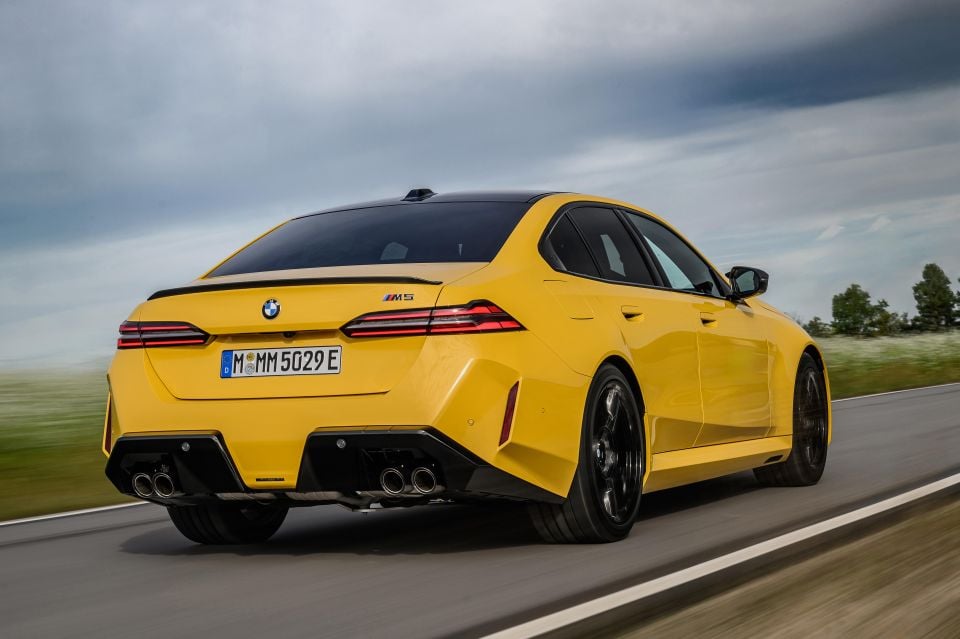
However, the M5 doesn’t feel fat nor lardy. The steering is sharp enough to make even this big car easy to place on narrow roads, and the rear-wheel steering – the first time such a thing has been fitted to an M5 – makes it seem far more agile than it has any right to be, helped by the brilliant Active M Differential that can shuffle power between the rear wheels.
Pressing on in the M5 reveals a core of precision and performance that entirely earns that M badge.
The M5 isn’t perfect – what car is? – but it’s more than good enough to stand shoulder to shoulder with its predecessors.
Only one variant of the M5 sedan is confirmed for Australia at launch. The M5 Touring will follow in the first half of 2025.
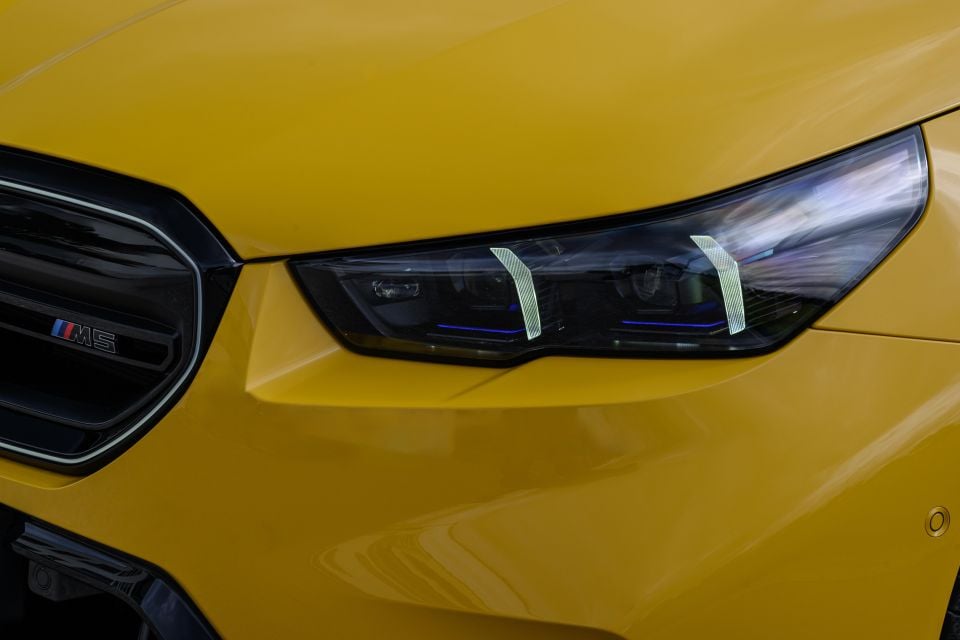



Equipment highlights for the 2025 BMW M5 sedan include:
The regular BMW 5 Series has been tested by ANCAP and took home a full five-star rating, with an 89 per cent score for adult occupant protection, 87 per cent for child occupants, 86 per cent for vulnerable road users and 81 per cent for active safety systems.
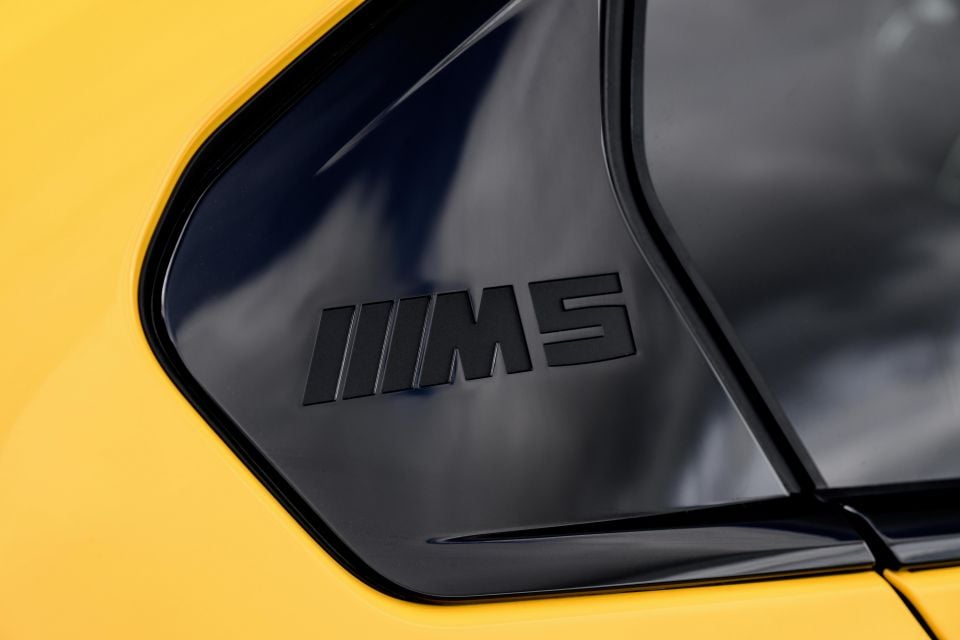
Where expert car reviews meet expert car buying – CarExpert gives you trusted advice, personalised service and real savings on your next new car.
Standard safety equipment includes:
The M5 is covered by BMW’s five-year, unlimited-kilometre warranty in Australia. The high-voltage battery for the plug-in hybrid system is separately covered for six years and 100,000km.
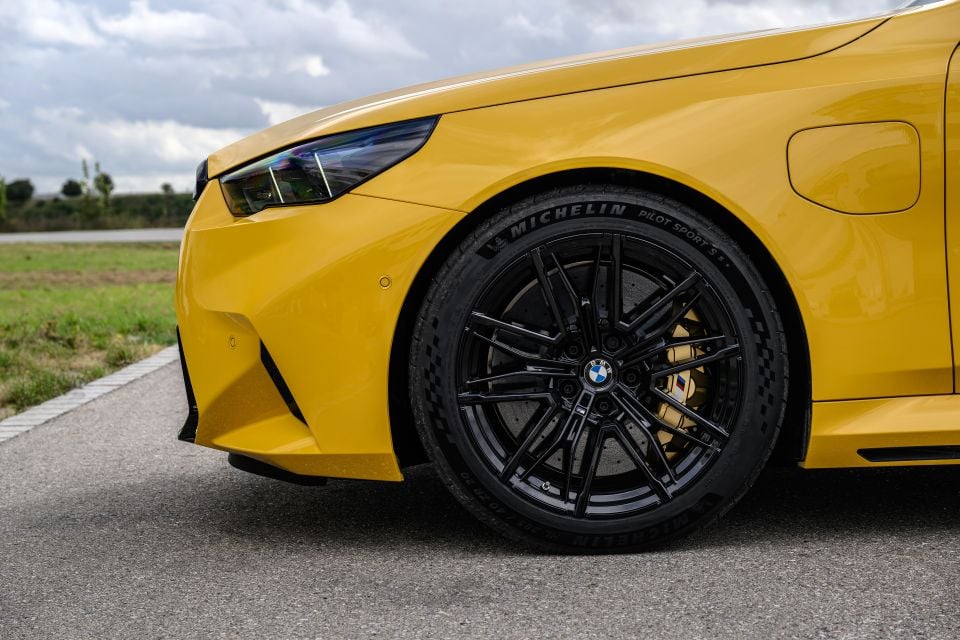
| Running costs | BMW M5 |
|---|---|
| Warranty | 5 years, unlimited km |
| Battery warranty | 6 years, 100,000 kilometres |
| Roadside assistance | 6 years, unlimited km |
| Inclusive servicing (POA) | 5 years, 80,000km |
To see how the BMW M5 compares with its rivals, use our comparison tool.
This could have all gone so horribly wrong.
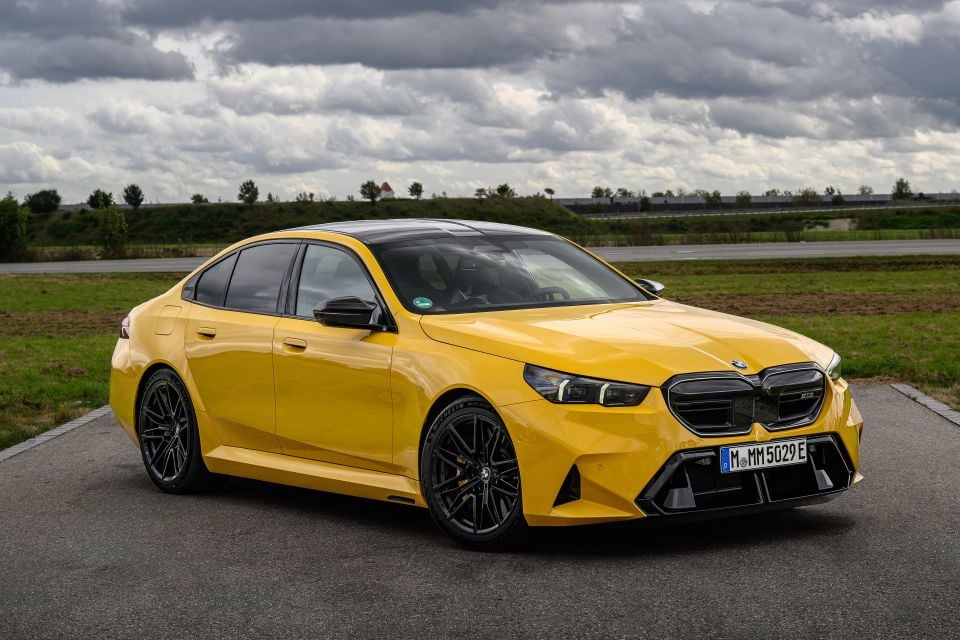
The plug-in hybrid element could have ruined that classic connection between an M5 driver and the mighty engine. The weight could have smothered all of the handling fun.
But neither has happened. The new M5 isn’t perfect – it really is very heavy and would have been more fun behind the wheel if it were lighter, while that complexity might come back to bite in reliability terms in years to come.
But it has achieved a remarkable melding of old-school performance heroics with 21st century electric abilities.
It’s fast, but civilised; explosive, but controlled; and above all subtle, but achingly desirable.
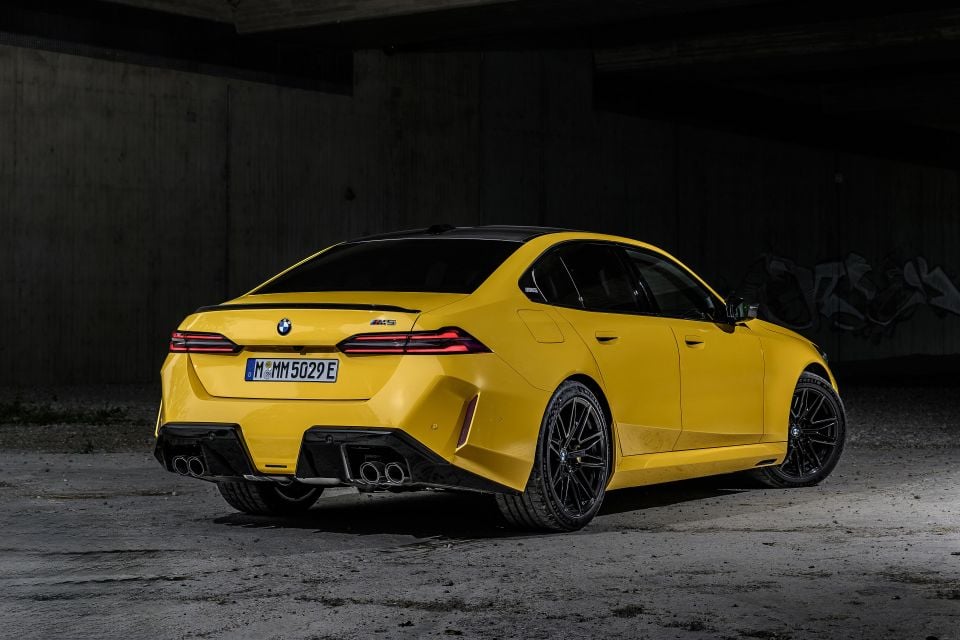
Interested in buying a BMW M5? Get in touch with one of CarExpert’s trusted dealers here.
MORE: Everything BMW M5
Where expert car reviews meet expert car buying – CarExpert gives you trusted advice, personalised service and real savings on your next new car.


Damion Smy
7 Hours Ago
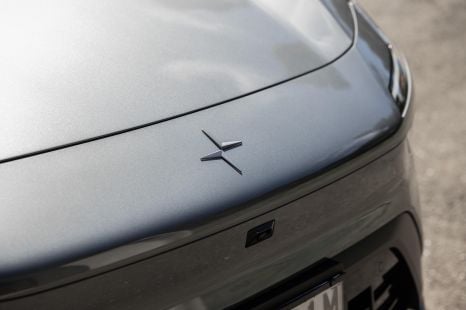

Damion Smy
8 Hours Ago


Damion Smy
9 Hours Ago
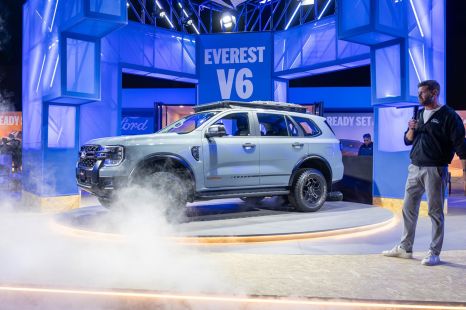

Damion Smy
12 Hours Ago


CarExpert.com.au
13 Hours Ago


Ben Zachariah
15 Hours Ago